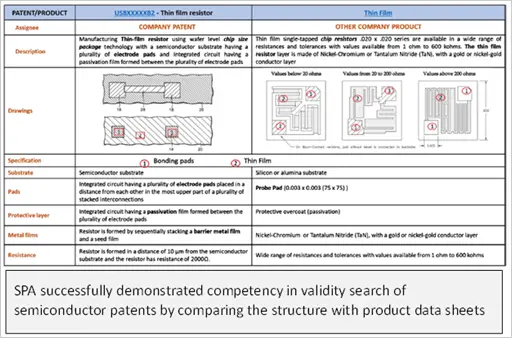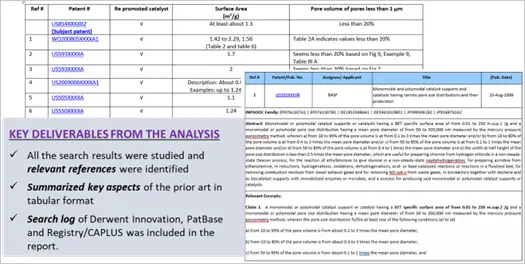Invalidation – an introduction
An invalidation search, also known as an opposition search or validity search, is a search conducted to determine if one or more claims of a granted patent are valid. The term “prior art” refers to information relating to a patent that has been published in any language, anywhere in the world, and existed before filing the patent. This includes patents and non-patent literature, such as journals, books, encyclopedias, thesis, product brochures, standards etc. Prior art also includes evidence of sale, previous public knowledge or public use.
A patent is granted only after a thorough prior art search is conducted by examiners at patent offices. So, the aim of an invalidation search is to find prior art that was not retrieved by the examiner during examination. As a result, the search challenges the validity of the granted patent.
There are various grounds for patent invalidation, including:
- Lack of novelty
- Lack of inventive-step
- Lack of industrial application
- Insufficient disclosure
- Claims not supported by matter disclosed in the specification
There are other legal grounds for patent invalidation, but from the prior-art perspective, novelty and inventive step are two primary grounds for a patent invalidation search.
Novelty is one of the main requirements of obtaining a patent, which indicates that the invention is new and not publicly available / known at the time the patent application is filed. In order to invalidate a patent on the grounds of lack of novelty, one must examine the novelty aspect of the claimed invention and identify the most relevant prior art that was publicly available at the time of filing the patent. Any prior art publicly available in the form of products, patents or scientific literature that is similar or closely matching the claimed invention could render the claimed invention invalid based on lack of novelty.
Among the other key requirements for patentability is the inventive step or non-obviousness requirement, according to which an invention should not be obvious in light of the prior art or to one with ordinary skill in the art. An invalidation of a patent on grounds of lack of novelty or obviousness requires identifying the closest prior art and comparing the technical aspects of the claimed invention with the prior art. Consider the similarities and differences between the claimed invention and whether it would seem obvious to someone skilled in the art at the time of its invention.
When to conduct a Patent Invalidation Search
A Patent Invalidation search is generally conducted in two scenarios –
Patent infringement: When a company faces allegations of patent infringement, one may conduct a patent invalidation search. In this case, the first line of defense for the accused company is to prove that the patent is invalid by identifying most relevant prior art. Therefore, there is no question of patent infringement.
Patent portfolio assessment: When a company is interested in buying patented technology or consider in-licensing of a technology, one may conduct a patent invalidation search. The aim of a validity search here is to know how strong the patent is. The company wants to confirm that if the patent is litigated in the future, it should be able to survive (will not get invalidated). This allows the company to be better prepared for a negotiation deal with the patent holder.
SciTech Patent Art Approach to Patent Invalidation Search:
The primary challenge in invalidity/validity searches is to find prior art (patents/ Non-Patent Literature – NPL) that was not retrieved by patent examiners during prosecution using conventional search approaches. SciTech Patent Art (SPA) has conducted patent invalidation searches for over two decades and has developed a Standard Operating Procedure (SOP) that includes unique approaches that often result in the identification of prior art useful to invalidate or limit the scope of the target patent. Our SOP includes:
1. Understanding the scope:
A patent claim recites a few aspects that define the underlying invention. Not all aspects are novel so it is critical to find the novel aspect of a claim that was the reason for its allowance. Our highly qualified subject matter experts read file history of the target patent thoroughly to identify novel aspects and then conduct in-depth searches for such identified aspects. This way, the data set is limited, and the probability of discovering relevant prior art is high.
2. Establishing the priority date:
As prior art published/filed before the priority date is only considered for patent invalidation, it is critical to identify the right priority date. We carefully review the claims of the invalidated patent as well as the cited priority documents. We figure out which priority document discloses all elements of the target claim, thus establishing the correct priority date for prior art searches.
3. Conducting a search:
- Appropriate sources and databases are identified to search for related technologies.
- For each searchable concept, the following will be considered:
- Synonyms
- US/UK variation in spellings
- Plurals
- Abbreviation, Acronyms
- Use of proper operators and proximity between searchable concepts
- Use of classification codes, especially for patents, to uncover the art not covered by key words
- Search for all publications of the inventors before filing date is also conducted. This step is conducted to check if there are prior patent publications of inventor(s) that claim similar subject matter. This step helps in identifying prior art related to double-patenting.
- Identifying non-patent information using SPA’s proprietary Deep Web tool to uncover more information than any traditional methods of searching
- Citation searches are conducted to further identify relevant art.
- Also conducted are in-depth searches for prolific authors, universities, institutes, companies identified during earlier stages.
4. Information sources:
- Patents
- Scientific and Technical journals
- Products in the market
- Magazine, newspaper or trade paper article written about invention
- Supplier catalogues
- Brochures
- Compendiums / abstracts
5. Reporting/Deliverables:
- Relevant prior art with highlight matching excerpts
- Claim chart i.e., comparison of claimed aspects with prior art
- Detailed search strategies with keywords and class codes covered
Databases used for prior art search

![]()
![]()


![]()
![]()

Additionally, SciTech Patent Art makes use of business intelligence databases such as Factiva and its proprietary Deep Web search engine as well as other sources of information, including conference proceedings, seminars, advertisements, and topic-specific sources, in order to conduct a prior art search.
Deep Web, a proprietary tool of SciTech Patent Art
Our scientists, aided by IT specialists, have developed a Deep Web research tool to improve the quality and time efficiency of non-patent literature searches. The Deep Web tools offers the following advantages:
- The search results are focused on the specific subject matter – Therefore, there is low noise with more relevant results.
- The search is more specific as highly potential websites are searched. Information extracted is more relevant and less likely to be discovered from traditional search engines. For example, in the case of packaging, all journal websites related to packaging are searched. Similarly, for food related topics, specific websites related to carbohydrates, proteins, etc. are searched accordingly.
- Eliminates need to go to multiple websites, as more selective websites are crawled.
- Graphical interface is available for rapid screening, downloading and sharing of results with colleagues.
Examples of Patent Invalidation Search Reports



